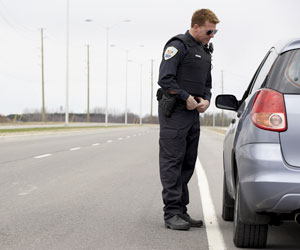Self-defense angle does not help driver charged with eluding
police
The defendant fled the traffic stop scene and called 911, informing the
dispatcher that an officer beat him with a baton and he was on his way
to the police station to make a report. Recently, the appeals court
upheld his conviction for eluding police.
By Joe Forward, Legal Writer,
State Bar of Wisconsin
 Oct. 11, 2010 – A
driver still “knowingly” flees or attempts to elude a
traffic officer in violation of Wisconsin law even if police know the
driver is en route to the police station, the district II Wisconsin
Appeals Court recently held.
Oct. 11, 2010 – A
driver still “knowingly” flees or attempts to elude a
traffic officer in violation of Wisconsin law even if police know the
driver is en route to the police station, the district II Wisconsin
Appeals Court recently held.
In 2007, Kenosha police stopped Daniel Hanson on the interstate for
speeding. The state and Hanson disputed the facts of subsequent
events.
Hanson said he exited the vehicle with a calm demeanor to show his
license, and the officer began screaming at him so he went back inside
the car. When he exited the vehicle a second time, Hanson said, the
officer drew his baton and hit him in the back of the head.
The officer testified that Hanson twice exited the vehicle and threw a
screaming fit, so he drew his baton but never used it to hit Hanson.
However, it is undisputed that Hanson fled the scene until police squad
cars boxed him in a short time later.
After leaving, Hanson called 911 to report that an officer
“’beat [him] in the head’ and to request assistance in
locating the nearest police station.” Hanson argued that he fled
the scene in self defense, fearing the officer would beat him with the
baton.
At trial, a jury found Hanson guilty on one count of eluding an officer
under Wis. Stat. section 346.04(3) and two counts of obstructing an
officer in violation of section 946.41(1).
Under section 346.04(3), a driver eludes police if he or she
“knowingly flee[s] or attempt[s] to elude any traffic
officer” after disregarding a visual or audible signal, and
thereby endangers the operation of the police vehicle, the traffic
officer or other vehicles.
Evidence was sufficient
Hanson appealed his conviction for eluding an officer, arguing that the
state failed to prove he “knowingly fled or attempted to
elude” police. That is, Hanson argued that he cannot flee and
elude police “if he calls 911 and tells the police where he is
going.”
But in State
v. Hanson, 2008AP2759-CR (Oct. 6, 2010), the appeals court held
that “as long as Hanson, after having received a visual or audible
signal from a traffic officer or marked police vehicle, fled or
attempted to elude that officer, it makes no difference under section
346.04(3) that he was fleeing to a police station.”
Sufficient evidence supported the jury verdict, the court concluded,
because there was ample evidence that Hanson operated the vehicle after
receiving visual and audio signals from officers and endangered the
operation of other vehicles.
Character evidence of officer inadmissible
Under Wis. Stat. section 904.04(1), character evidence is inadmissible
as irrelevant unless offered by the accused to prove a character trait
of a “victim.”
Hanson argued the trial court “erred in excluding character
evidence as to [the officer’s] reputation in the community as
being ‘confrontational, aggressive and hot tempered’”
because the officer was the “victim” of Hanson’s
conduct. The real controversy – Hanson’s self-defense claim
– was not tried because of the exclusion, Hanson argued.
But the appeals court refused to hold, under State v. Haase,
2006 WI App 86, 293 Wis. 2d 322, 716 N.W.2d 526, that “a police
officer is always a victim of an ‘eluding an officer’
offense.”
“That an officer can be a victim of the crime of eluding an
officer for purposes of restitution does not mean that an officer is
victimized as a result of every such crime,” the court wrote.
The circuit court did not err in concluding that the officer was not a
“victim” for purposes of admitting character evidence, the
appeals court ruled.
Because the jury heard testimony about events from Hanson’s
perspective, the court found the exclusion did not prevent the real
controversy from being tried.
Appealing to juror’s emotions
Hanson argued the court should not have allowed the prosecution to
address previous instances where police have been injured or killed
during a routine traffic stop. Such references “appealed to the
emotions of the jurors and prejudiced them against him,” Hanson
argued.
But the appeals court disagreed, stating the references “were
relevant and provided context for his concern when Hanson exited his
vehicle on the interstate and would not cooperate.”
Redaction of 911 recording
Under Wis. Stat. section 752.35, discretionary reversal was required
because the 911 recording admitted into evidence contained unredacted
hearsay statements about his culpability, Hanson argued.
But the jury received a cautionary instruction to decide the case based
on the evidence presented and not conclusions offered by the 911
dispatcher, the court explained. In addition, the defense never
requested the recording be redacted.
Thus, the court held that discretionary reversal was not
warranted.
